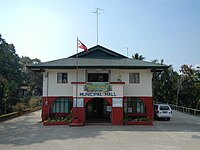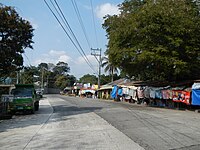Sablan, Benguet
Sablan | |
|---|---|
| Municipality of Sablan | |
 | |
 Flag  Seal | |
 Map of Benguet with Sablan highlighted | |
 Sablan Location within the Philippines | |
| Coordinates: 16°30′N 120°31′E / 16.5°N 120.52°ECoordinates: 16°30′N 120°31′E / 16.5°N 120.52°E | |
| Country | Philippines |
| Region | Cordillera Administrative Region |
| Province | Benguet |
| District | Lone district |
| Barangays | 8 (see Barangays) |
| Government | |
| • Type | Sangguniang Bayan |
| • Mayor | Manuel B. Munar Jr. |
| • Vice Mayor | Arthur C. Baldo |
| • Representative | Nestor B. Fongwan |
| • Electorate | 7,603 voters (2019) |
| Area | |
| • Total | 105.63 km2 (40.78 sq mi) |
| Elevation | 497 m (1,631 ft) |
| Highest elevation | 1,117 m (3,665 ft) |
| Lowest elevation | 51 m (167 ft) |
| Population (2020 census) [3] | |
| • Total | 11,588 |
| • Density | 110/km2 (280/sq mi) |
| • Households | 2,599 |
| Economy | |
| • Income class | 5th municipal income class |
| • Poverty incidence | 6.75% (2015)[4] |
| • Revenue | ₱87,996,242.81 (2020) |
| • Assets | ₱216,706,429.65 (2020) |
| • Expenditure | ₱70,753,139.12 (2020) |
| • Liabilities | ₱43,283,453.63 (2020) |
| Service provider | |
| • Electricity | Benguet Electric Cooperative (BENECO) |
| Time zone | UTC+8 (PST) |
| ZIP code | 2614 |
| PSGC | |
| IDD : area code | +63 (0)74 |
| Native languages | Kankanaey Ibaloi Ilocano Tagalog |
Sablan, officially the Municipality of Sablan (Ilocano: Ili ti Sablan; Tagalog: Bayan ng Sablan), is a 5th class municipality in the province of Benguet, Philippines. According to the 2020 census, it has a population of 11,588 people. [3]
Etymology[]
The term "Sablan" was derived from the local word "Sabdang", a local tree which thrived in the area.[5]
History[]
Sablan was created officially as a municipal district on July 1, 1927, under Executive Order No. 61 dated May 17, 1927 by then American Governor General Leonard Wood.
Geography[]
Sablan is at the mid-western tip of Benguet. It is bounded by Kapangan on the north, Tublay on the northeast, La Trinidad on the east, Baguio City in the southeast, Tuba in the south, Aringay on the southwest, and Burgos to the west.
According to the Philippine Statistics Authority, the municipality has a land area of 105.63 square kilometres (40.78 sq mi) [6] constituting 3.81% of the 2,769.08-square-kilometre- (1,069.15 sq mi) total area of Benguet.
Barangays[]
Sablan is politically subdivided into 8 barangays.[7]
| PSGC | Barangay | Population | ±% p.a. | |||
|---|---|---|---|---|---|---|
| 2020 [3] | 2010 [8] | |||||
| 141112002 | Bagong | 6.1% | 705 | 764 | −0.82% | |
| 141112003 | Balluay | 4.6% | 536 | 507 | 0.57% | |
| 141112004 | Banangan | 15.6% | 1,808 | 1,756 | 0.30% | |
| 141112005 | Banengbeng | 9.3% | 1,072 | 1,108 | −0.34% | |
| 141112006 | Bayabas | 21.3% | 2,467 | 2,068 | 1.83% | |
| 141112007 | Kamog | 12.7% | 1,468 | 1,064 | 3.37% | |
| 141112010 | Pappa | 5.1% | 593 | 594 | −0.02% | |
| 141112011 | Poblacion | 24.2% | 2,808 | 2,650 | 0.60% | |
| Total | 11,588 | 10,511 | 1.01% | |||
Climate[]
| Climate data for Sablan, Benguet | |||||||||||||
|---|---|---|---|---|---|---|---|---|---|---|---|---|---|
| Month | Jan | Feb | Mar | Apr | May | Jun | Jul | Aug | Sep | Oct | Nov | Dec | Year |
| Average high °C (°F) | 22 (72) |
23 (73) |
24 (75) |
25 (77) |
24 (75) |
23 (73) |
21 (70) |
21 (70) |
21 (70) |
22 (72) |
23 (73) |
22 (72) |
23 (73) |
| Average low °C (°F) | 12 (54) |
12 (54) |
14 (57) |
16 (61) |
17 (63) |
16 (61) |
16 (61) |
16 (61) |
16 (61) |
15 (59) |
14 (57) |
12 (54) |
15 (59) |
| Average precipitation mm (inches) | 15 (0.6) |
16 (0.6) |
24 (0.9) |
33 (1.3) |
102 (4.0) |
121 (4.8) |
177 (7.0) |
165 (6.5) |
144 (5.7) |
170 (6.7) |
56 (2.2) |
23 (0.9) |
1,046 (41.2) |
| Average rainy days | 6.3 | 6.6 | 9.5 | 12.8 | 20.6 | 23.5 | 25.4 | 23.4 | 23.2 | 21.4 | 14.0 | 8.2 | 194.9 |
| Source: Meteoblue [9] | |||||||||||||
Demographics[]
| Year | Pop. | ±% p.a. |
|---|---|---|
| 1939 | 2,930 | — |
| 1948 | 2,786 | −0.56% |
| 1960 | 4,741 | +4.53% |
| 1970 | 5,681 | +1.82% |
| 1975 | 7,345 | +5.29% |
| 1980 | 7,900 | +1.47% |
| 1990 | 8,440 | +0.66% |
| 1995 | 9,170 | +1.57% |
| 2000 | 9,652 | +1.10% |
| 2007 | 10,890 | +1.68% |
| 2010 | 10,511 | −1.28% |
| 2015 | 11,457 | +1.65% |
| 2020 | 11,588 | +0.22% |
| Source: Philippine Statistics Authority [10] [8] [11][12] | ||
In the 2020 census, Sablan had a population of 11,588. [3] The population density was 110 inhabitants per square kilometre (280/sq mi).
Economy[]
| Poverty Incidence of Sablan | |
| Source: Philippine Statistics Authority[13][14][15][16][17][18] | |
Education[]
Public schools[]
As of 2014, Sablan has 14 public elementary schools and 2 public secondary schools.[19][20][21]
|
|
Private schools[]
is the only private secondary school in the municipality, located at barangay Poblacion.
Transportation[]
Major roads within the Sablan include the Naguilian Road (formerly Quirino Highway) and Asin–Nangalisan–San Pascual Road.
Gallery[]
Municipal hall
Downtown Sablan
Fruit and souvenir stalls along Naguilian Road
Immaculate Conception Parish Church
Rural landscape
References[]
- ^ Municipality of Sablan | (DILG)
- ^ "2015 Census of Population, Report No. 3 – Population, Land Area, and Population Density" (PDF). Philippine Statistics Authority. Quezon City, Philippines. August 2016. ISSN 0117-1453. Archived (PDF) from the original on May 25, 2021. Retrieved July 16, 2021.
- ^ a b c d Census of Population (2020). "Cordillera Administrative Region (CAR)". Total Population by Province, City, Municipality and Barangay. PSA. Retrieved 8 July 2021.
- ^ https://psa.gov.ph/sites/default/files/City%20and%20Municipal-level%20Small%20Area%20Poverty%20Estimates_%202009%2C%202012%20and%202015_0.xlsx; publication date: 10 July 2019; publisher: Philippine Statistics Authority.
- ^ "Municipality of Sablan, Benguet profile". DILG - CAR. Department of the Interior and Local Government (Philippines). Retrieved 16 September 2014.
- ^ "Province: Benguet". PSGC Interactive. Quezon City, Philippines: Philippine Statistics Authority. Retrieved 12 November 2016.
- ^ "Municipal: Sablan, Benguet". PSGC Interactive. Quezon City, Philippines: Philippine Statistics Authority. Retrieved 8 January 2016.
- ^ a b Census of Population and Housing (2010). "Cordillera Administrative Region (CAR)". Total Population by Province, City, Municipality and Barangay. NSO. Retrieved 29 June 2016.
- ^ "Sablan: Average Temperatures and Rainfall". Meteoblue. Retrieved 21 March 2020.
- ^ Census of Population (2015). "Cordillera Administrative Region (CAR)". Total Population by Province, City, Municipality and Barangay. PSA. Retrieved 20 June 2016.
- ^ Censuses of Population (1903–2007). "Cordillera Administrative Region (CAR)". Table 1. Population Enumerated in Various Censuses by Province/Highly Urbanized City: 1903 to 2007. NSO.
- ^ "Province of Benguet". Municipality Population Data. Local Water Utilities Administration Research Division. Retrieved 17 December 2016.
- ^ "Poverty incidence (PI):". Philippine Statistics Authority. Retrieved 28 December 2020.
- ^ https://psa.gov.ph/sites/default/files/NSCB_LocalPovertyPhilippines_0.pdf; publication date: 29 November 2005; publisher: Philippine Statistics Authority.
- ^ https://psa.gov.ph/sites/default/files/2003%20SAE%20of%20poverty%20%28Full%20Report%29_1.pdf; publication date: 23 March 2009; publisher: Philippine Statistics Authority.
- ^ https://psa.gov.ph/sites/default/files/2006%20and%202009%20City%20and%20Municipal%20Level%20Poverty%20Estimates_0_1.pdf; publication date: 3 August 2012; publisher: Philippine Statistics Authority.
- ^ https://psa.gov.ph/sites/default/files/2012%20Municipal%20and%20City%20Level%20Poverty%20Estima7tes%20Publication%20%281%29.pdf; publication date: 31 May 2016; publisher: Philippine Statistics Authority.
- ^ https://psa.gov.ph/sites/default/files/City%20and%20Municipal-level%20Small%20Area%20Poverty%20Estimates_%202009%2C%202012%20and%202015_0.xlsx; publication date: 10 July 2019; publisher: Philippine Statistics Authority.
- ^ "Masterlist of Public Elementary Schools for the School year 2012- 2013" (XLSX). Department of Education (Philippines), July 15, 2013. Retrieved 28 December 2014.
- ^ a b "Masterlist of Secondary Schools (School Year 2013- 2014)". Department of Education (Philippines), July 4, 2013. Archived from the original (XLSX) on 1 July 2014. Retrieved 20 November 2014.
- ^ a b "Masterlist of Public Schools SY 2013-2014" (XLSX). Department of Education (Philippines), 22 October 2014. Retrieved 28 December 2014.
External links[]
![]() Media related to Sablan, Benguet at Wikimedia Commons
Media related to Sablan, Benguet at Wikimedia Commons
- Municipalities of Benguet






